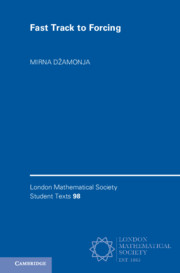Book contents
- Frontmatter
- Dedication
- Contents
- Preface
- Part I Let’s Be Independent
- Part II What is New in Set Theory
- 10 Introduction to Part Two
- 11 Classical Extensions
- 12 Iterated Forcing and Martin’s Axiom
- 13 Some More Large Cardinals
- 14 Limitations of Martin’s Axiom and Countable Supports
- 15 Proper Forcing and PFA
- 16 N2 and other Successors of Regulars
- 17 Singular Cardinal Hypothesis and Some PCF
- 18 Forcing at Singular Cardinals and Their Successors
- References
- Index
16 - N2 and other Successors of Regulars
from Part II - What is New in Set Theory
Published online by Cambridge University Press: 28 September 2020
- Frontmatter
- Dedication
- Contents
- Preface
- Part I Let’s Be Independent
- Part II What is New in Set Theory
- 10 Introduction to Part Two
- 11 Classical Extensions
- 12 Iterated Forcing and Martin’s Axiom
- 13 Some More Large Cardinals
- 14 Limitations of Martin’s Axiom and Countable Supports
- 15 Proper Forcing and PFA
- 16 N2 and other Successors of Regulars
- 17 Singular Cardinal Hypothesis and Some PCF
- 18 Forcing at Singular Cardinals and Their Successors
- References
- Index
Summary
The iteration theorems we presented so far give a wealth of results about the subsets of ω and, to some extent, ω1. For example, a typical result obtained by the application of iterated proper forcing is the construction of a model in which ω1 = □ < ■ = ω2, where □ and ■ are cardinal invariants of the continuum. One can consult the book [3] by Tomek Bartoszyński and Haim Judah for various instances of this method. The difficulties of generalising this context to the larger cardinals, even of the form κ+ for κ satisfying κ<κ = κ, turn out to be substantial. In the above mentioned exposition of iterated forcing Baumgartner [5, §4] wrote
- Type
- Chapter
- Information
- Fast Track to Forcing , pp. 104 - 125Publisher: Cambridge University PressPrint publication year: 2020

